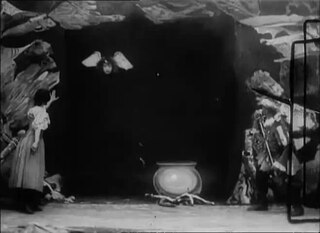
A cliffhanger or cliffhanger ending is a plot device in fiction which features a main character in a precarious or difficult dilemma or confronted with a shocking revelation at the end of an episode or a film of serialized fiction. A cliffhanger is hoped to incentivize the audience to return to see how the characters resolve the dilemma.

A story within a story, also referred to as an embedded narrative, is a literary device in which a character within a story becomes the narrator of a second story. Multiple layers of stories within stories are sometimes called nested stories. A play may have a brief play within it, such as in Shakespeare's play Hamlet; a film may show the characters watching a short film; or a novel may contain a short story within the novel. A story within a story can be used in all types of narration including poems, songs, and video games.
A plot device or plot mechanism is any technique in a narrative used to move the plot forward. A clichéd plot device may annoy the reader and a contrived or arbitrary device may confuse the reader, causing a loss of the suspension of disbelief. However, a well-crafted plot device, or one that emerges naturally from the setting or characters of the story, may be entirely accepted, or may even be unnoticed by the audience.
A backstory, background story, back-story, or background is a set of events invented for a plot, presented as preceding and leading up to that plot. It is a literary device of a narrative history all chronologically earlier than the narrative of primary interest.
Foreshadowing is a narrative device in which a storyteller gives an advance hint of what is to come later in the story. Foreshadowing often appears at the beginning of a story, and it helps develop or subvert the audience's expectations about upcoming events.
In fiction, a false protagonist is a literary technique, often used to make the plot more jarring or more memorable by fooling the audience's preconceptions, that constructs a character who the audience assumes is the protagonist but is later revealed not to be.

Coin magic is the manipulating of coins to entertain audiences. Because coins are small, most coin tricks are considered close-up magic or table magic, as the audience must be close to the performer to see the effects. Though stage conjurers generally do not use coin effects, coin magic is sometimes performed onstage using large coins. In a different type of performance setting, a close-up coin magician will use a large video projector so the audience can see the magic on a big screen. Coin magic is generally considered harder to master than other close-up techniques such as card magic, as it requires great skill and grace to perform convincingly, and this requires much practice to acquire.
A plot twist is a literary technique that introduces a radical change in the direction or expected outcome of the plot in a work of fiction. When it happens near the end of a story, it is known as a twist or surprise ending. It may change the audience's perception of the preceding events, or introduce a new conflict that places it in a different context. A plot twist may be foreshadowed, to prepare the audience to accept it, but it usually comes with some element of surprise. There are various methods used to execute a plot twist, such as withholding information from the audience, or misleading them with ambiguous or false information. Not every plot has a twist, but some have multiple lesser ones, and some are defined by a single major twist.
A dream sequence is a technique used in storytelling, particularly in television and film, to set apart a brief interlude from the main story. The interlude may consist of a flashback, a flashforward, a fantasy, a vision, a dream, or some other element.
A flashback is an interjected scene that takes the narrative back in time from the current point in the story. Flashbacks are often used to recount events that happened before the story's primary sequence of events to fill in crucial backstory. In the opposite direction, a flashforward reveals events that will occur in the future. Both flashback and flashforward are used to cohere a story, develop a character, or add structure to the narrative. In literature, internal analepsis is a flashback to an earlier point in the narrative; external analepsis is a flashback to a time before the narrative started.
A flashforward is a scene that temporarily takes the narrative forward in time from the current point of the story in literature, film, television and other media. Flashforwards are often used to represent events expected, projected, or imagined to occur in the future. They may also reveal significant parts of the story that have not yet occurred, but soon will in greater detail. It is similar to foreshadowing, in which future events are not shown but rather implicitly hinted at. It is also similar to an ellipsis, which takes the narrative forward and is intended to skim over boring or uninteresting details, for example the aging of a character. It is primarily a postmodern narrative device, named by analogy to the more traditional flashback, which reveals events that occurred in the past.
This article contains a list of cinematic techniques that are divided into categories and briefly described.

The Prestige is a 2006 psychological thriller film directed by Christopher Nolan, written by Nolan and his brother Jonathan and based on the 1995 novel by Christopher Priest. It stars Hugh Jackman as Robert Angier and Christian Bale as Alfred Borden, rival stage magicians in Victorian London who feud over a perfect teleportation trick.
This is a glossary of conjuring terms used by magicians.
In film production, cinematography and video production, a reaction shot is a shot which cuts away from the main scene in order to show the reaction of a character to it. The reaction shot is a basic unit of film grammar.
Mind control has proven a popular subject in fiction, featuring in books and films such as The Manchurian Candidate and The IPCRESS File, both stories advancing the premise that controllers could hypnotize a person into murdering on command while retaining no memory of the killing. As a narrative device, mind control serves as a convenient means of introducing changes in the behavior of characters, and is used as a device for raising tension and audience uncertainty in the contexts of the Cold War and terrorism. Mind control has often been an important theme in science fiction and fantasy stories. Terry O'Brien comments: "Mind control is such a powerful image that if hypnotism did not exist, then something similar would have to have been invented: the plot device is too useful for any writer to ignore. The fear of mind control is equally as powerful an image."

"The Dragon's Call" is the first episode of the first series of the British fantasy-adventure family television series Merlin. Written by Julian Jones and directed by James Hawes, the episode was first broadcast on BBC One on 20 September 2008.

Magic, which encompasses the subgenres of illusion, stage magic, and close-up magic, among others, is a performing art in which audiences are entertained by tricks, effects, or illusions of seemingly impossible feats, using natural means. It is to be distinguished from paranormal magic which are effects claimed to be created through supernatural means. It is one of the oldest performing arts in the world.

The Magic Sword; or, A Medieval Mystery is a 1901 British short silent fantasy film, directed by Walter R. Booth, featuring a mediaeval knight battling to save a damsel from an ogre and a witch. The film, "is impressively elaborate, with single shots containing multiple trick effects achieved through complex double exposures and superimpositions," and according to Michael Brooke of BFI Screenonline, "was so startling that it moved the legendary stage illusionist J.N. Maskelyne to describe The Magic Sword as the finest trick film made up to then."
This glossary of motion picture terms is a list of definitions of terms and concepts related to motion pictures, filmmaking, cinematography, and the film industry in general.






